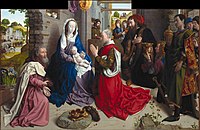Adoration of the Kings (Gossaert)
| The Adoration of the Kings | |
|---|---|
 | |
| Artist | Jan Gossaert |
| Year | 1510–1515 |
| Medium | Oil on oak |
| Dimensions | 177.2 cm × 161.8 cm (69.8 in × 63.7 in) |
| Location | National Gallery, London |
The Adoration of the Kings is a large oil-on-oak painting by Jan Gossaert (born Jean Gossart, also known as Jan Mabuse), dated to 1510–15, depicting the Adoration of the Magi. Although Gossaert's name is signed on the border of Balthazar's richly embroidered headdress, and on a collar worn by Balthazar's turbaned attendant, the painting was occasionally attributed to Albrecht Dürer in the 17th and 18th centuries. In 2010, Ainsworth suggested that the work was a collaboration between Gossaert and Gerard David.
Painting
In the centre of the painting, the
To the right of Caspar stands Melchior holding aloft his gift, accompanied by four attendants, with more attendants approaching from the distance on horseback. Balthazar stands to the left with his gift and three attendants. Balthazar's richly decorated crown is inscribed with his name at its peak and Gossaert's name towards the bottom; Gossaert's name also appears on a collar worn by Balthazar's turbaned black attendant. Further left, two more attendants in exotic dress watch from a window.
Nine angels (perhaps representing the
Technical details and composition
The work was painted on a wooden panel consisting of six oak boards, laid vertically, measuring 177.2 centimetres (69.8 in) high by 161.8 centimetres (63.7 in) wide. The paint was applied to a ground of chalk fixed with animal glue, with a thin
Gossaert's composition draws from several sources. It takes its main inspiration from the
-
TheMonforte altarpiece by Hugo van der Goes
-
Albrecht Dürer's engraving of Saint Eustace
-
Adoration of the Kings by Martin Schongauer
History
The origins of the painting are unclear. It may have been commissioned by
A painting matching its description came to London in 1787 and was sold at an auction held in London by John Greenwood the following year. It came into the possession of art dealer Michael Bryan by 1795, and was sold to Frederick Howard, 5th Earl of Carlisle, who displayed it at Castle Howard. It was restored in 1884 by William Morrill, and then moved to Naworth Castle.
Copies are held by the
References
- The Adoration of the Kings, National Gallery
- The Adoration of the Kings, National Gallery, key facts
- The Adoration of the Kings Archived 2021-02-27 at the Wayback Machine, National Gallery, introduction
- Jean Gossart, The Adoration of the Kings, Lorne Campbell, from The Sixteenth Century Netherlandish Paintings with French Paintings before 1600, London 2011; published online 2011 Archived 2021-02-27 at the Wayback Machine



